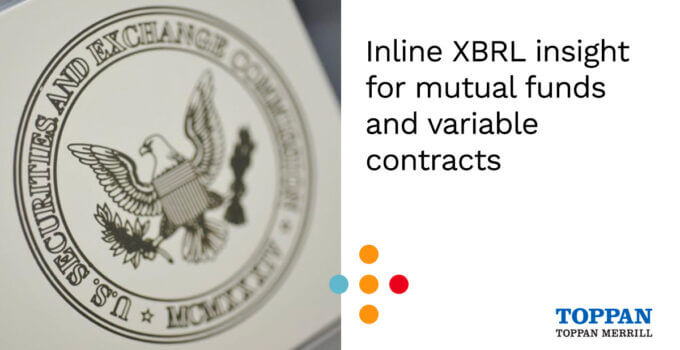The deadlines for financial services providers to start filing certain disclosures in Inline XBRL format has been in effect for Large Fund Groups ($1B+ in net assets) since September 17, 2020. For Small Fund Groups, Closed-End Funds (CEFs), Business Development Companies (BDC’s), and Variable Life and Annuity contracts, Inline XBRL is quickly approaching.
With large fund groups being the first incorporating iXBRL, what are we learning? In short, be prepared. The U.S. Securities and Exchange Commission (SEC) adopted iXBRL requirements for mutual funds, closed end funds, and variable annuity and variable life insurance products, which were long expected. But, that doesn’t make meeting the mandate any less overwhelming—especially for those adding XBRL tags for the first time. Throw in the added curveball of learning new procedures and processes with remote teams, proper preparation and testing of new workflows can get difficult…fast.
XBRL format vs. iXBRL format
Both formats are intended to make data easier to analyze and use. You can add machine-readable XBRL tags to pieces of financial data to classify information according to a standard taxonomy. The iXBRL format allows you to embed those machine-readable XBRL tags into an HTML document, so humans can read it, too.
Mutual funds, closed end funds, and variable annuity and variable life insurance products face different requirements for their iXBRL filing. Below is a recap of iXBRL compliance dates for mutual funds, business development companies, closed end funds, and variable annuity and variable life insurance contracts. Then will close with some recommendations.
Fund Groups (Open-End, ETFs):
The SEC is requiring large fund groups with $1 billion or more in assets to file fund risk/return summary information in iXBRL format for initial registration statements (or an annual update to a registration statement) effective on or after Sept. 17, 2020 – currently in effect.
The deadline is Sept. 17, 2021, for fund groups that fall short of that asset threshold.
By the way…. Prior to the September 21st EDGAR release, redlining was not supported in an iXBRL filing. Its important to note that the SEC’s September 21st EDGAR release changed how redlining in an EDGAR filed document needs to be created, which can present unique technical challenges. Its important to test file early and often.
Variable contract products (VA, VUL):
The SEC recently announced its rule to streamline variable annuity and variable life insurance disclosures for new investors. The goal is to make it easier for investors to evaluate which product is best for them.
The rule requires providers to tag disclosures in registration statements or amendments on Forms N-3, N-4, and N-6 forms of prospectuses that include information that varies from your registration statement. (Check out the “filings to be tagged” in the 713-page rule for more details.) Essentially, you’ll be tagging information to help investors more easily compare key benefits or features, fees or costs, principal risks of investing, standard death benefits, other available benefits, investment options, taxes, and conflicts of interest.
The compliance deadline is Jan. 1, 2023.
By the way… In order to leverage technology to help investors understand their variable contracts, the final rule includes provisions that are meant to enhance investors’ understanding of special terms when they view the summary prospectus online. Specifically, the rule requires that investors either be able to view the definition of each special term used in an online summary prospectus upon command, or to move directly back and forth between each special term and the corresponding entry in any glossary or list of definitions that the summary prospectus includes. For example, investors could view the definitions of special terms by moving or “hovering” the computer’s pointer or mouse over the term, or selecting the term on a mobile device.
Closed-End Funds (CEFs):
A separate rule requires business development companies (BDCs) and closed end funds (CEFs) to provide management’s discussion of fund performance (MDFP) in annual shareholder reports starting Aug. 1, 2021. As part of that rule, they also must comply with iXBRL reporting requirements for financial statement data, registration statement information, and prospectus information for affected funds that are eligible to file a short-form registration statement, starting Aug. 1, 2022.
Plan now to meet the deadlines
Companies have been using Toppan Merrill to meet XBRL and iXBRL requirements for years. We’ve found a few strategies to be helpful for meeting deadlines with as little stress as possible.
Based on what we’ve seen, here’s what we recommend:
- Start early on plans for meeting the mandate, so you’re not scrambling before the deadline. Having a buffer should also reduce stress, especially if we run into more unexpected disruptions like natural disasters or another wave of COVID-19 infections.
- As you work through vendor decisions, look for end-to-end content management and reporting solutions, so you don’t have to work with multiple vendors. It’s nice to have everything in one place, so you can aggregate data, create reports, collect sign-offs and approvals, add XBRL tags, and file in a single platform or application.
- Speaking of disruptions, there’s no telling how long it will be before we’re all back in the office. If the COVID-19 pandemic exposed gaps in business continuity, make a plan now to ensure you can still meet filing deadlines if critical employees are forced to work remotely.
- Since 2011, Toppan Merrill has provided an XBRL Dashboard that provides an easy to use and intuitive review portal – allowing filers to review their XBRL tagged content prior to filing by utilizing any or all of the SEC’s rendering models.
Toppan Merrill is here to help.
Should you have questions about the 1940 Securities Act and the compliance requirements for investment companies, visit ToppanMerrill.com, connect with us via [email protected] or by phone at 800.688.4400.



